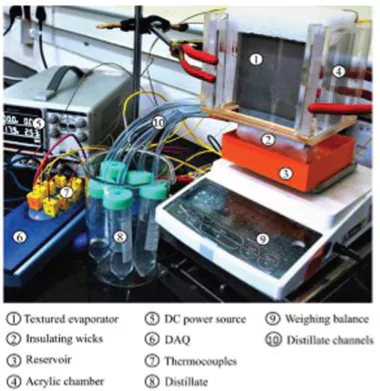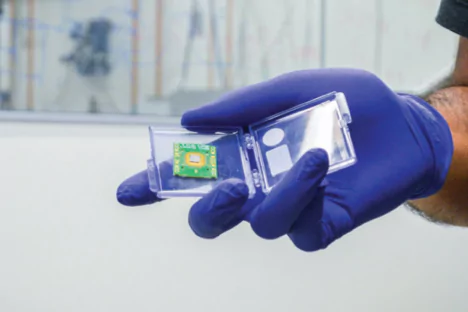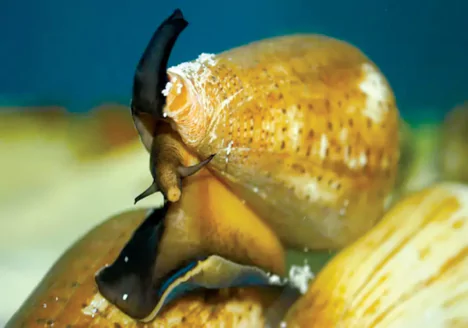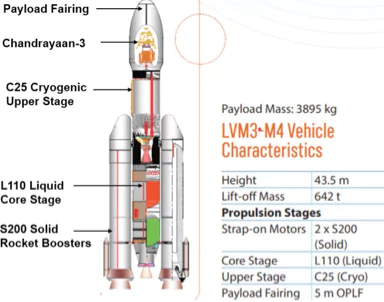Science Reporter Magazine Summary August 2023
Science Reporter Magazine Summary August 2023
- 2) Programmable 3D Printed Wound Dressing
- 3) Robomuse 5.0 — A Mobile Robot for Heavy Payloads
- 4) Researchers Develop New Superconducting Diode
- 5) “Statistics Nobel” for Indian-origin Scientist
- 6) Scientists Discover Dense Exoplanet
- Article 1: Chandrayaan-3 India’s Quest for the Moon
- Article 2: Bringing Field Botany Alive
- Article 3: Biocomposites to Ensure Environmental Sustainability
- Article 4: Resistant starch Type III
- Article 5: Why are venomous snails so fascinating to scientists?
NEWS IN BRIEF:
1) Novel Solar Desalination System for Remote Areas
- The most common methods for desalination are membrane-based reverse osmosis and thermal desalination. However, both consume a lot of energy.
- As an alternative to such solar stills, the IISc (Indian Institute of Science), Bengaluru, has developed a novel design for a solar-powered desalination unit.
- It is more energy-efficient, cost-effective and portable, making it convenient to set up in areas with limited access to continuous electricity.

2) Programmable 3D Printed Wound Dressing
- In view of the problems in changing dressings frequently in burn patients, researchers from the University of Waterloo have developed programmable 3D-printed reusable hydrogel wound dressing.
- The newly developed dressing will be beneficial in the healing process. The study was published in the Journal Colloids and Interfacial Science.

3) Robomuse 5.0 — A Mobile Robot for Heavy Payloads
- A mobile robot called “Robomuse 5.0”, which would be suitable for various industries to carry payloads up to 100 kg and perform object manipulation by installing an arm on top of it, has been developed by researchers at IIT Delhi.
- This mobile robot is also a good research platform for various teaching and research organisations.
- The mobile robot, Robomuse 5.0, can have multiple applications, including the transportation of heavy items on a factory shop floor.
- If a manipulator is fitted on its top, the mobile manipulator can perform pick-and-place operations, e.g., to dispose of a faulty item in a bin.

4) Researchers Develop New Superconducting Diode
- The University of Minnesota Twin Cities-led team has developed a new superconducting diode, a key component in electronic devices, that could help scale up quantum computers for industry use and improve the performance of Artificial Intelligence systems. The paper was published in Nature Communications.
- Compared to other superconducting diodes, the researchers’ device is more energy efficient, can process multiple electrical signals at a time, and contains a series of gates to control the flow of energy, a feature that has never before been integrated into a superconducting diode.

5) “Statistics Nobel” for Indian-origin Scientist
- In a moment of rare glory for India and Indian Science, Prof. Calyampudi Radhakrishna Rao has been declared the winner of the current year’s International Prize in Statistics, regarded as the Nobel equivalent for the number crunchers.
- Rao has been selected for the honour for his contribution to the world of statistics that has a profound influence on science.

6) Scientists Discover Dense Exoplanet
- A new Jupiter size exoplanet with the highest density known till this date, and mass 13 times that of Jupiter, has been discovered by an international team of scientists at the Exoplanet Research Group of the Physical Research Laboratory (PRL), Ahmedabad.
- The team includes scientists from India, Germany, Switzerland and the USA. The discovery of this massive exoplanet was made using the indigenously made PRL Advanced Radial-velocity Abu-sky Search spectrograph (PARAS) at the 1.2 m telescope of PRL at its Gurushikhar Observatory in Mt Abu by measuring the mass of the planet precisely.
- The newly discovered exoplanet is found around the star called TOI4603 or HD 245134.
- NASA’s Transiting Exoplanet Survey Satellite (TESS) initially declared TOI4603 as a possible candidate to host a secondary body of unknown nature.
- Using PARAS, scientists discovered it as a planet by measuring the mass of the secondary body and hence the planet is called TOI 4603b or HD 245134b.
What are Exo planets?
- Massive giant exoplanets are those having a mass greater than four times that of Jupiter.
- The newly discovered exoplanet TOI 4603b is one of the most massive and densest giant planets that orbit very close to its host star at a distance less than 1/10th the distance between our Sun and Earth.

- The figure on the left shows an artistic impression comparing the distances between the TOI-4603 star-planet system and the Sun-Mercury and Sun-Jupiter systems. It is noteworthy that the TOI-4603b planet, which has the same size as Jupiter, is situated more than fifty times closer to its star than Jupiter is to the Sun. On the right is a comparison between the TOI-4603b planet and Jupiter,which is 13 times more massive than Jupiter.
- This discovery marks the third exoplanet discovery by India, and by the PRL scientists using the PARAS spectrograph and the PRL 1.2 m telescope, following the discoveries in 2018 (K2-236b) and 2021 (TOI-1789b).
Article 1: Chandrayaan-3 India’s Quest for the Moon
- The Moon, the largest and brightest celestial object in the night sky, has always been much coveted by humankind.
- The only natural satellite of the Earth, it has been a centre of attention for ages, more than any other heavenly body.
- It is expected that an understanding of the Moon may provide us a pathway to unravel the early evolution of our solar system and that of Earth.
Past expeditions:
Chandrayaan-1
- It was India’s first lunar and highly successful mission.
- It was launched by PSLV-C11 on 22 October 2008 and was operational till 29 August 2009.
- Chandrayaan-1 discovered traces of water on the Moon — a path-breaking discovery in space science. Global imaging of the Moon was another major achievement of this mission.
Chandrayaan-2
- India’s second mission to the Moon, Chandrayaan-2 was launched on board GSLV Mk III (Geosynchronous Satellite Launch Vehicle, now renamed now as LVM III) rocket on 22 July 2019.
- While Chandrayaan-1 was designed for remote sensing observations of the Moon surface, Chandrayaan-2 is a composite module consisting of three components: a lunar orbiter, Vikram-Lander and Pragyan-Rover.
Chandrayaan-3
- Chandrayaan-3 is a follow-on mission to Chandrayaan-2 to demonstrate end-to-end capability in safe landing and roving on the lunar surface.
- LVM III M4 (4 indicates 4th operational flight of the vehicle) was used for lifting off Chandrayaan-3, which placed the integrated spacecraft in an Elliptic Parking Orbit (EPO) of size ~170 x 36,500 km.
- As Chandrayaan-3 is a repeat mission its cost is relatively less.
- The total cost of the Chandrayaan-3 mission is over ₹615 Crores.
- In comparison, the Chandrayaan-2 mission cost was ₹978 Crores. This includes the launch cost of around ₹375 Crores.
Mission Objectives:
The Chandrayaan-3 mission has three main objectives:
- The primary objective is going to be a safe, soft and precise landing of the Lander on the lunar South Pole.
- To demonstrate Rover operations on the Moon surface, and
- To carry out on-site scientific experiments on the lunar soil.
-
- To achieve the above mission objectives, several advanced technologies have been introduced in Chandrayaan-3 including instrumentation redundancy, structural rigidity and multiple contingencies.
- The primary objectives of Chandrayaan-3 are to demonstrate the capability of the Vikram-Lander’s soft landing on the south polar region of the Moon where no country has attempted to reach so far and to conduct the Pragyan rover on the lunar surface.
Mystery of the Lunar South Pole
- The lunar south pole region is of special interest as Chandrayaan-1 found signatures of water ice deposits in the craters of the Moon’s poles.
- Since then, numerous missions have made similar detections, including Cassini, Deep Impact, LRO and LCROSS missions.
- The south pole zones of the Moon that remain in shadow are much larger than the North Pole. There is a possibility of the presence of icy walls in the permanently shadowed areas.
- These cold trap craters in the south pole region may also contain a fossil record of the early Solar System. Ice found inside these craters and within the lunar soil could provide a vital source of water as humans venture back to the lunar surface.
- That’s why the south pole is considered a big resource rich target.
- This region is also considered very difficult to explore as it is home to some harsh conditions, including temperatures as low as -233°C.
- The Chandrayaan-3 Lander is expected to soft land at a latitude of about 69.37°S, 32.35°E slightly off the site of Chandrayaan-2 (70.9° S, 22.7° E high plain between two craters, Manzinus-C and Simpelius-N).
- The mission aims to study the unique geology and composition of this unexplored region.
Technical details of Chandrayaan 3:
- Chandrayaan-3 consists of two Modules — Propulsion and Lander (Lander + Rover).
- After landing, the Rover will roll out to the Moon surface. Propulsion Module (PM):
- The PM will be used as a relay satellite; it will remain in lunar orbit to enable communications with Earth.
- The main function of PM is to carry the Lander Module (Lander + Rover configuration) from launch injection (170 x 36,500 km Earth orbit) to 100 km circular polar Lunar orbit.
- Thereafter it will get separated from the Lander Module.
- As a value addition, the Propulsion Module also includes one scientific payload, Spectro-polarimetry of HAbitable Planet Earth (SHAPE), which will be operated post-separation of the Lander Module.
- SHAPE payload is designed to study the spectral and Polari metric measurements of Earth from lunar orbit.
- The reflected light would enable us to probe a variety of Exo-planets that would qualify for habitability (or for the presence of life).

Lander-Vikram Module:
- The Lander (Vikram named after Indian space programme pioneer Vikram Sarabhai) is box shaped (200 x 200 x 116.6 cm) with four landing legs.
- It is responsible for the precise soft landing on the lunar surface.
- The four legs of the Lander will absorb energy while touching down on the Moon and provide stability to it for further operations.
- After the Lander lands on the Moon, the ramp opens and the Rover descends to the lunar surface.
The Lander carries the Rover inside a compartment. It has a ramp for deployment onto the lunar surface. Similar to Chandrayaan-2, Chandrayaan-3 Lander has four scientific payloads to perform experiments on the lunar surface.
- Radio Anatomy of Moon Bound Hypersensitive Ionosphere and Atmosphere (RAMBHA): The lunar ionosphere is a highly dynamic plasma environment. The Langmuir probe RAMBHA will measure the near surface plasma (ions and electrons) density and its variation with time.
- Chandra’s Surface Thermo-Physical Experiment (CHaSTE): ChaSTE consists of a thermal probe with sensors and a heater and measures the vertical temperature gradient and thermal conductivity into the lunar regolith down to a depth of ~10 cm near the polar region.
- Instrument for Lunar Seismic Activity (ILSA): ILSA is a triple axis, MEMS-based seismometer that can detect minute ground displacement, velocity, or acceleration caused by lunar quakes. Its primary objective is to characterise the seismicity around the landing site.
- Laser Retroreflector Array (LRA): LRA provided by NASA’s Goddard Space Flight Centre is employed as a passive experiment to understand the dynamics of Earth’s Moon system. It will take precise measurements of the distance between the reflector on the lunar surface and satellites in lunar orbit.

Conclusion:
- The successful landing of Chandrayaan-3 Lander would make India only the fourth nation to accomplish landing and roving on the Moon’s surface after Russia, United States and China.
- Further, India is poised to reach the harshest but more resourceful south pole terrain of Moon that no one has ever been able to succeed.
Article 2: Bringing Field Botany Alive
- The throbbing and rich discipline that today’s Botany is, owes a lot to its founders who travelled all over the face of Earth to see how and which plants were growing in different parts and geographical niches of the world.
- Equipped with a keen sense of observation, these founders gave birth to the fascinating discipline of Field Botany that records all about the habit and habitat of a plant and assists in taxonomic identification of plants including the ones that look alike but are in reality different.
What is field study?
- Field study is an essential and integral part of the learning about living organisms including plants, animals and the teeming microbes that outnumber all plants and animals taken together.
- Learning biology in field settings is a real time experience which helps in the development of creativity, environmental awareness and a sense of accountability towards nature among students.
- However, during the last two decades, there has been considerable decline in the interest for field-studies among both students and teachers in the area of botany.
- This loss of interest has amplified further during recent times leading to a total disconnect between learning botany in laboratory and in nature.
Current scenario in India:
- With the emergence of biotechnology in India during the last few decades, there is a rush of interest in molecular biology and genomics, ignoring the importance of basic botany.
- One has to realise that without knowing about plants, molecular studies will have little value.
- The challenge in fact is to combine and relate good holistic Botany with good molecular biology of the plants.
- Unfortunately, most teachers are also attracted towards the modern molecular branches of botany resulting in the tragic neglect of the plant as a whole.
Role of Botanical Excursions:
- Historically, short and long-distance botanical excursions used to be an essential component of syllabi and it was mandatory for every student to take part in these excursions without fail.
- Gradually, the long-distance botanical excursions became ‘Fun Tours’ while short-distance botanical excursions turned to be essentially ‘Picnics’ in the midst of plants.
- Currently, this activity has either been completely abandoned (with few exceptions) or replaced by entertainment exercise.
Benefits of Botanical Excursions:
- The botanical excursions provided opportunities to students to observe plants in their natural habitats of different geo-climatic regions of the country.
- Sensitising students about the importance of conservation of biodiversity is an important facet of our teaching-learning process in field settings which automatically will inspire students to observe plants and make limited collection under the guidance of a knowledgeable field-botanist.
Importance of Field Botany:
- The importance of field study is immense as it provides opportunities to create not only better science but also better scientists, citizens, and people thereby substantially affecting the human-nature relationship that forms the basis for sustainability.
- Classroom teaching of botany needs to be supplemented with field-trips. In fact, teachers too need to acquire field knowledge and also to be trained to take students to field excursions.
- Organisations like the Botanical Survey of India (BSI), State Forest Departments, and Indian Council of Forestry Research and Education (ICFRE) can play a pivotal role in this direction by introducing and conducting regular refresher courses involving ‘field-based studies’.
- It can be made mandatory for colleges and university to send at least one faculty member of botany for such refreshers courses on regular basis.
- To strengthen our base of experts in field-botany, governments could consider creating additional positions in universities.
Article 3: Biocomposites to Ensure Environmental Sustainability
Context:
- Traditional materials, such as metals and plastics, have been widely used in various engineering applications, but their properties and performance characteristics are often limited, making them unsuitable for modern engineering requirements.
- As a result, there has been a growing interest in developing new materials, such as composite materials, that can offer enhanced properties and performance.
What are composite materials?
- Composites are a distinctive type of materials that are created by blending two or more dissimilar materials to form a novel material with superior properties compared to its constituent parts.
- The resulting composite material can be designed to possess specific characteristics such as high strength, stiffness, toughness, and corrosion resistance, among others.
- Main Components:
- Reinforcement
- Matrix
The reinforcement provides the composite with its strength and stiffness.
The matrix holds the reinforcement in place and transfers the load between the reinforcement.
Uses:
- Composite materials have been used in a variety of engineering applications, ranging from aerospace to biomedical engineering.
- The use of composite materials has also led to significant advancements in the design and manufacture of various engineering components, such as aircraft parts, automotive components, and medical implants.
Advantages:
- One of the most significant advantages of composite materials is their high strength-to weight ratio, which makes them particularly attractive for applications where weight reduction is critical.
- Additionally, composite materials can exhibit excellent fatigue resistance, corrosion resistance, and impact resistance, making them ideal for applications where durability and reliability are essential.
What are Biocomposites?
- Biocomposites have emerged as a sustainable and eco-friendly alternatives to traditional composites.
- Biocomposites are composed of natural fibers, such as wood, hemp, or bamboo as reinforcement material, combined with a biopolymer matrix, such as starch, cellulose, or Polylactic Acid (PLA).
Advantages:
- biodegradability,
- renewability,
- reduced environmental impact.
Applications:
- Biocomposites have a wide range of potential applications in various fields, such as packaging, construction, automotive, and aerospace industries.
Biocomposites Manufacturing:
- The fibers can be processed and modified in various ways, such as chemical treatments and mechanical processing, to improve their properties and compatibility with the biopolymer matrix.
- Matrix materials: Some commonly used biopolymers for Biocomposites include:
- Starch
- Cellulose
- Lignin
- Proteins
- Polylactic Acid (PLA)
- One common method involves blending the natural fibers with a biopolymer matrix, such as starch or Polylactic Acid (PLA).
- Another method involves impregnating the natural fibers with the biopolymer matrix using techniques such as solution casting or hot pressing.
- In some cases, Biocomposites can also be prepared using 3D printing techniques, in which the natural fibers and biopolymer matrix are printed layer-by-layer to form a composite structure.
Biocomposites Vs Traditional Composites
Biocomposites have several advantages over traditional composites which include:
- Biodegradability
- Reduced Environmental Impact
- Renewability
- Lightweight and high strength
- Customizability
Challenges for Biocomposites:
- Limited availability of Raw materials
- High Production costs
- Limited processing options
- Limited disposal options
- Limited mechanical properties
- Lack of standardization
Bioplastics:
- Bioplastics are a type of plastic that are made from renewable biomass sources, such as vegetable fats and oils, corn starch, pea starch, or microbiota, instead of traditional petrochemicals.
- This is in contrast to Biocomposites which are made by combining natural fibers with a biopolymer matrix, resulting in a material that is both strong and lightweight.
Conclusion:
- Despite the challenges like high production costs, limited processing and disposal options, and limited availability of raw materials, the development and adoption of Biocomposites have the potential to significantly reduce the impact of human activities on the environment.
- By using renewable materials and reducing waste generation, Biocomposites can contribute to a more sustainable future.
- The use of Biocomposites in various applications such as construction, automotive, aerospace and packaging is increasing, and research is ongoing to further improve their properties and reduce their costs thus making them contribute to a more sustainable future.
Article 4: Resistant starch Type III
Context:
- White rice obsessed people often have an emotional attachment with numerous avatars of bhat, or rice.
- It is more than a basic that serves as a suitable canvas for the traditional regional side dishes. Its distinctive taste, flavour, texture and white colour also feeds the spirit.
What is Glycemic load?
- Glycemic load is a practical measure that counts gram of carbohydrate in a served food contributing to glucose level in the bloodstream.
What is Glycemic index?
- It is a ratio between how quickly a carbohydrate can increase blood glucose level immediately after meal as compared to that of a reference (generally glucose).
Effects of excess consumption:
- Metabolic disorder such as type II diabetes, unusual weight gain, high blood pressure, etc.
Miracle Starch:
- The primary ingredient of rice is starch, a naturally occurring polymeric carbohydrate consisting of amylose and amylopectin.
- Carbohydrate especially starch is often maligned since they are digested rapidly giving a high glucose spike.
- However, not all the starch we consume is broken down. There is a hidden magical starch which is non-digestible.
- Starch that is resistant to digestion by the small intestine is known as resistant starch.
- In the colon, it feeds the beneficial gut microbiota, resulting in essential metabolites such as propionate, acetate, butyrate (2 to 4 carbon chain length FAs) and acetoacetate, β-hydroxybutyrate (ketone bodies) and assists in reducing the occurrence of colon cancer.
Benefits:
- This kind of resistant starch acts as soluble, fermentable fibre and is lower in calories than conventional starch thus reducing appetite and supporting weight management.
Moderate-level resistant starch consumption can increase insulin (peptide hormone secreted by pancreas) sensitivity and hence manage blood glucose levels (glycemia), lowering the incidence of type II diabetes.
Article 5: Why are venomous snails so fascinating to scientists?
Context:
- There are over 700 recognised species of cone snails, making them one of the most diverse groups of venomous animals on Earth.
- Cone snails are known for their strikingly beautiful shells. The shells come in a variety of colours, patterns, and shapes, making them popular among shell collectors.
- These cone snails are highly venomous and hunt by instantly killing their prey.
Hunting mechanism of Cone snails:
- Cone snails have a unique hunting mechanism — they possess a modified radula, which is a feeding organ found in mollusks.
- This radula is transformed into a harpoon-like structure called a radular tooth, which they use to inject venom into their prey.
- The venom contains a complex mixture of toxins, typically consisting of hundreds of different compounds.
- Each cone snail species produces a unique venom cocktail, allowing them to specialise in hunting specific prey.
About Cone Snails:
- Despite their potent venom, cone snails are generally slow-moving creatures.
- They rely on their camouflage and stealth to surprise their prey.
- They extend a proboscis to consume their prey once they immobilise the prey with their venom.
- While most species prey on other mollusks, they also feed on fish, worms, and even cone snails.
- Some cone snails are specialised hunters, targeting specific prey species, while others have a more generalist diet.

Scientists researching on venom to cure diabetes:
- Cone snail releases insulin that can lower the blood sugar level of its prey within seconds, causing it to die.
- Researchers have been fascinated by how fast this insulin works which is not the case with the human insulin.
- Human insulin also tends to form clumps, which stabilise the substance and make it simpler to store in the body, but it is unable to function until the clumps break down.
- Contrarily, insulin or the venom from cone snails don’t clump and could offer insight into creating non-clumping insulin for faster diabetes treatment.
Conclusion:
- Cone snail venom contains diverse bioactive compounds, offering potential medical applications and contributing to our understanding of molecular biology and pharmacology.
- Breakthrough in this research could prove wonders for mankind.





